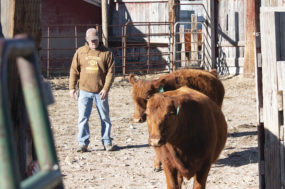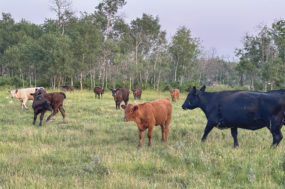Future profitability will depend on developing these heifers in the proper manner so they calve, breed back and become productive members of the cowherd.
“Some producers develop these heifers really well and get them bred – then fall down. These females need to be managed separately until the first calf is weaned.
It’s a significant investment when the decision is made to retain that heifer,” says Dr. John Jaeger, extension beef specialist with Kansas State University.
Proper first breeding
It all starts when those heifers are bred. The timing of this is critical to set them up for success and, hopefully, many productive years.
“You have to breed those heifers to calve at least three weeks before the cow herd. That extra time will give her the opportunity to breed back and calve on schedule with the cowherd,” says Dr. Justin Rhinehart, extension beef specialist with the University of Tennessee.
“If you don’t breed heifers to calve at least 15 to 30 days ahead of the cow herd, extra management wouldn’t make that much difference because you’re not giving those 2-year-olds enough time to breed back,” Jaeger says.
“Once she calves, this will be the most nutritionally demanding time in her life. We like to begin their second calving season one week later, and it has increased heifer retention by 10 to 15 percent.”
Calving heifers in the proper body condition score (BCS) has many benefits. Sire selection is another important part of the equation. Limiting calving problems will help those heifers get ready to re-breed.
“I like to see those heifers gaining 1 pound per day through that last trimester and for them to reach 80 percent of their mature weight by calving,” Jaeger says.
“Keeping these heifers in good condition will help limit dystocia because there is actually more potential for calving problems if you calve thin heifers.
If heifers are having a problem, you need to know when to intervene. It’s always better to be early with the assistance rather than too late because hard births take longer to recover from.”
What she eats
Nutritional programs need to be designed to get heifers in the proper condition. Each operation has a recipe for developing heifers that will best fit the management scenario.
“Those heifers need to calve in a BCS of 5½ to 6. Heifers that are in good condition will have stronger calves, calve better and breed back quicker,” Rhinehart says.
“Feed costs and experience has led some operations to developing heifers in a little slower manner, depending more on forage than feed.
This is a good concept, but make sure heifers are in proper body condition before mid-gestation to late gestation because they’ll never catch up if they are too thin at that point.
Most spring-calving programs will have to supplement these heifers because forage will not be enough this time of year.”
“She needs to be a body score 5, and to do this we have to monitor nutritional quality,” Jaeger says. “When the forage quality is marginal, like with stockpiled forages, protein supplementation is extremely efficient.
We have found infrequent supplementation with distillers grains gets the same response as traditional supplements. This will improve performance and increase re-breeding rates.”
Separation and sorting
A lot of management programs keep heifers separate from the cowherd to better manage them through the difficult times.
Further sorting could help utilize labor and feed resources more efficiently. Getting heifers settled in to the calving area is another important part of the protocol.
“Ultrasound heifers and separate those that are A.I.-bred from the ones that are bull-bred. This makes for a group of females that will calve in a short timeframe, and you don’t have to wade through the whole herd to check the ones that are close,” Jaeger says.
“Feed those heifers in late afternoon or early evening so more of them will calve in the daylight. Heifers tend to surprise us because those low birthweight bulls have a shorter gestation period. Have them where they need to be at least 30 days before the due date.”
“Hand-feeding those heifers may be the best option because you need to feed them late afternoon or early evening, and it makes most operators more accountable to get out there and do it,” Rhinehart says.
“Take time to walk through those heifers; get them acclimated in case you have to assist a heifer at birth.
“When you know due dates, it’s easy to sort heifers up into calving groups and stage them to make more efficient use of your time.
Sort heifers and get them where they are going to calve early; the worst mistake a lot of people make is trying to move heifers too close to calving.”
Healthy horizon ahead
While proper nutrition and good mineral supplementation are very important parts, herd health will rank up there when it comes to calving season. Calf survivability could be greatly affected with proper herd health.
“Make sure heifers are up-to-date on the vaccination program before they reach the third trimester,” Rhinehart says.
“Some producers make it work working those cattle a little later and giving them a scour guard. I don’t like to work heifers through the chute that late in pregnancy.
The last month can have a big effect on calf vigor and built-in immunity. Poor health, low BCS or cold stress can have lasting effects on calves.”
“Work with your veterinarian to make sure you are on track with the health program,” Jaeger says. “The last injection should occur two weeks before calving.
Good colostrum is extremely important, and that comes from heifers that have been vaccinated properly. Hopefully, that good colostrum will really help calf survival rates because she’s healthy and hasn’t been nutritionally stressed.”
For most operators it seems there are never enough hours in a day, and calving season adds to that burden. Doing the homework and being prepared will ease the stress of calving heifers.
“When heifers have been sorted, it’s pretty easy to make a checklist of the things that need to get done before calving season.
It will make things a lot easier,” Jaeger says “Sample your forages to know what type of supplement you will need and how much.
Stockpile some winter forage to help ease costs. Make sure you know nutritional requirements and have them on a ration that will keep them in good condition.”
“Planning calving season around all the other things that need to get accomplished is hectic for some operations. Producers have to be diligent in their planning,” Rhinehart says.
“Test your forages and develop a strategy to get heifers through calving. Make sure ingredients for the rations are either in the commodity bin or you have the right harvested forages.
It is really hard to change a ration right in the middle of the process, and you can’t run out of feed.”
Profits lie ahead
The future of the operation could depend on getting heifers into production. Low cow numbers, high market price and grass in drought-stricken areas will ultimately lead to expansion.
Investing in the right females is one thing, but buying into proper management could pay many future dividends to the operation.
“When you keep a heifer, you get no revenue for approximately three years, and that’s a big investment,” Jaeger says.
“Heifers are the future and should have the best genetics that will move the herd forward. It’s a priority to keep her in the herd.
This is an important period in replacement heifer development and retention. If you do it right, and she re-breeds in 60 to 90 days postpartum, it’s the first step to begin to capture some return on our investment.”
“We can’t afford to lose heifers as 2-year-olds because we don’t have any revenue,” says Rhinehart. “Those heifers need to breed back.
Small increases in percentages of wet 2-year-olds bred back could have a huge economic impact. Longevity of females is where all the money is.
If they’re prepared for the next step in life, you’re set up for success. She’ll pay you back if you can keep her in the herd seven or eight years.” ![]()
Clifford Mitchell is a freelance author based in Oklahoma.







